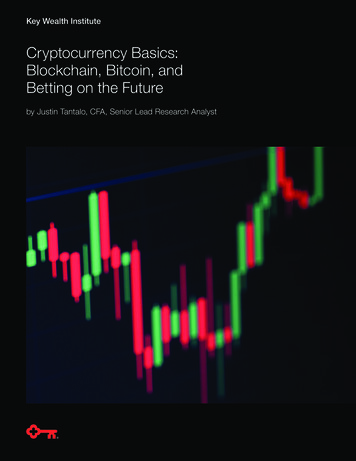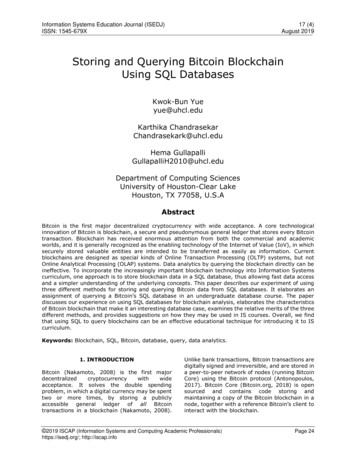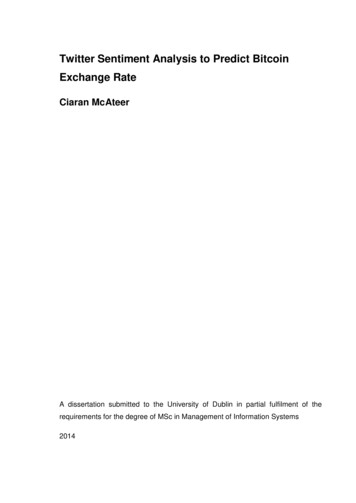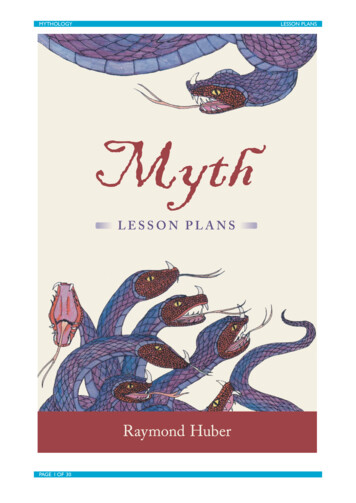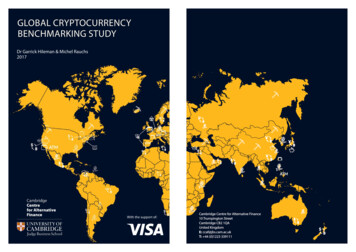
Transcription
Bitcoin and Cryptocurrency: Myths and realitiesPart 2: The JourneyThis is a story of secret beginnings. A story of a brilliant idea, born of trying times. A tale of upsand downs, theft and despair, and triumphant comebacks. The story of an underdog,attempting to overcome the odds. No, this is not a fairy tale, but a real-live story of a currency. Yes, you read right – currency. This is the story of the beginning of Bitcoin and itsjourney through the years. And the best part? The story isn’t quite finished. yet.Now I’m sure many of you will know bits and pieces of this story that I’m about to begin: who isthe founder of Bitcoin – Satoshi Nakamoto; why did he start this new currency – because of the2008 financial crisis; how did he manage to fix the problem of double-spending that had beenplaguing the digital currencies of the time – by using blockchain. But this is a mere summary ofwhat is, quite truthfully, a saga. And as the saying goes, the devil is in the details So, let’s divein!Legend has it, that Satoshi Nakamoto first began working on the concept of Bitcoin in 2007, butthe concept was only documented and presented to the public through his Bitcoin whitepaperin October of 2008. What was so special about this little old paper? Well, for one, it describedthe Bitcoin currency, but far more importantly it detailed the use of a new technology calledblockchain so that the Bitcoin currency could never be copied, thus solving the problem ofdouble-spending. About a week after the white paper was published the Bitcoin Project wasregistered on SourceForge.net – a website that was focused on the development anddistribution of open-source software. A couple of months later, on January 3 of 2009, theGenesis Block was mined.Got a few questions after reading that last sentence? I’m sure you do. So, let’s get someanswers. First off, what is mining? Well, if you read on, there’s a whole section dedicated tomining, so we’ll get to that in a while. For now, simply think of mining as a highly competitive,magical process that results in a miner (a user on the Internet) finding a Bitcoin – much likeminers in the old ages finding gold nuggets! Secondly, what is a Genesis Block? That, I believewe should find out right now. The Genesis Block or Block 0 of the Bitcoin blockchain is thegranddaddy of every other bitcoin block out there. How is this possible? Well, each new blockthat is created in the blockchain is connected to the one that came before it hence they alltrace back to Block 0. Generally, the difficulty of mining blocks is so great that it requires aspecialized graphics card but Satoshi Nakamoto was able to mine Block 0 by simply using a CPUsince, at the time, the difficulty was set to 1 – much like the first levels of a computer gamewould start at a difficulty level of ‘Easy’. Compare that with a difficulty level of1
10,183,488,432,889 - which is the difficulty level of mining a block on the Bitcoin blockchain asat the time of writing this article – and you will perhaps begin to get an inkling of how theBitcoin blockchain has expanded in the past decade or so.Unlike in any of the blocks that came after, Satoshi Nakamoto decided to leave a little messagein the code of Block 0. It read “The Times 03/Jan/2009 Chancellor on brink of second bailout forbanks”. This was a reference to an article that appeared in the London Times on the day thatthe Genesis Block was created, and it provided details on yet another bailout of banks by theBritish government. Although the message was brief and didn’t give any more details as to whythis article was important, many have interpreted this as a message from Satoshi, expressing hisdistaste for the banks and the middlemen and pointing to yet another reason why he created amore people-driven currency.A lesser-known, yet interesting fact about the Genesis Block is that throughout the years,people have been treating it as a sort of wishing well. How so? Well, the original Genesis Blockcontained 50 Bitcoins in total and these have never been spendable – they have always stayedput. But since the beginning of the system people have been sending bitcoins to this address(yes this ‘address’ business will be explained later!) as a sort of tribute to the creator, in theprocess quite possibly making all of those coins un-spendable! The Genesis Block is, for manyBitcoin aficionados, synonymous with Satoshi Nakamoto, so in a way, sending Bitcoins to thisaddress is a way for them to be closer to their Crypto God, the Creator of the Bitcoin Universe.After establishing the Genesis Block, Version 0.1 of Bitcoin was released on January 9, 2009,and interestingly enough, in the release note of the software, Satoshi talked about the fact thatthe total circulation of Bitcoins would be 21 Million, meaning that there would only ever be 21million coins in the Bitcoin ecosystem. Now, no one really knows why Satoshi decided on thisexact figure, although as is common with everything related to Bitcoin, there are many theoriesfloating around, and in this case, many of those theories tend to be highly technical.To put things into perspective, let us say that the overall supply of Bitcoin can be dividedinto three parts. One is circulating supply, meaning the number of coins that are out incirculation, either being traded or held by users on the network. Certain cryptocurrencies haveall their coins pre-mined, or release all the coins from the beginning of the project, or evenmine the coins over time. Irrespective of which method is used, the circulating supply meanswhatever is available and circulating at present. Second is the total supply – referring to thenumber of coins in existence at the moment. This would include all created coins, whether incirculation or not. And thirdly, there is the maximum supply for a coin – meaning that if anumber exists for maximum supply, then that particular coin will not be created again once it2
reaches this number. According to CoinMarketCap, an aggregator website on cryptocurrencyinformation, at the time of writing this article, the total circulating supply of Bitcoin stood at17,907,850 – roughly 18 million coins. With a maximum supply of 21,000,000 coins, this meansthat we have a further 3 million coins to mine.And this perhaps is the best place to delve into the question of mining. Now I do plan to get alittle technical here, so those of you who don’t want to clutter your brain with the detailsshould skip right on ahead. For the rest of you brave souls, let us start with the basics. Simplyput, mining is a way for you to earn cryptocurrency without having to buy it using money.Interestingly, when Bitcoin first started, mining one block would earn a miner 50 BTC (Bitcoin).In 2012, it was halved to 25 BTC, in 2016 again halved to 12.5 BTC and is expected to go downto 6.25 BTC in 2020. This halving process occurs once in every 210,000 blocks or roughly every 4years. Right, back to the topic at hand - what do miners actually DO, when they mine? They arein essence being paid to work as auditors of the system. They are verifying past Bitcointransactions to ensure that double spending has not occurred.Imagine that you had a Rs.100/- note and a copy of that same note. If you were to go out andspend both those bills, someone taking the trouble to look at both bills carefully would knowthat the serial numbers on the notes are the same and hence would know that one of them is afake. What miners do is somewhat similar to this. Currently, when a miner has verified 1MB(megabyte) worth of transactions to ensure there is no double-spending, then they are eligiblefor the reward of 12.5 BTC. Eligible – yes but not certain to receive it. Why? Well, in order toreceive the reward, the miner has to meet two conditions. One is that he has to verify 1MBworth of transactions. But secondly, he has to be the first miner to get the right answer to anumeric problem. For those of you interested in the Bitcoin jargon, this process is known as‘proof of work’. The good news here is that there is really no advanced mathematics involved inthis process – it's just a lot of guesswork. What the miner is actually trying to do is come upwith a 64-digit hexadecimal number called a ‘hash’, that is less than or equal to a given targethash.Think of it this way. I have 4 friends to whom I say that I’m thinking of a number between 1 and100 and they’re required to guess what it is. My number is 25. A and B guess numbers above 25and therefore are immediately out of the running. C guesses 24 and D guesses 20. They’d bothbe right because 24 25 and 20 25. No extra points for C just because he guessed closer! C andD are both eligible for the reward. This happens quite often in the Bitcoin network wheremultiple miners guess right and the decision for the reward is then based on which miner hasverified the most transactions. So, transpose this problem of guessing the number to theBitcoin network – now the number that the miners are guessing is not between 1 and 100 but a3
64-digit number and instead of just 4 people guessing, there are now millions. There are pagesand pages of more details for anyone interested in the subject of mining but since too much ofa good thing is never advisable, I believe it is in our best interests to gently leave this topichere.Now, considering the trying circumstances under which Bitcoin was created and the substantialamount of thought and effort put in to launching this currency, you would think that the firsttransaction of Bitcoin - when the currency was actually used to buy something in the real world- would be a momentous occasion, and the product being bought would be of considerableimportance. You would be wrong! The first real-world transaction of Bitcoin was for 10,000 BTCin 2010 and it took place in Jacksonville, Florida when a programmer by the name of LaszloHanyecz used it to buy pizza. At the time, the exchange rate for BTC to USD put the pizzaaround 25, but at the height of its price of 19,783.06 per 1 BTC in 2017, this particular pizzawas worth 197,830,600. Imagine that!Bitcoin was not, however, always used to buy such innocuous things as fast food. As the valueof Bitcoin increased over the next few years and more people started to join the network, thepeople who conducted dubious business on the fringes of society also began to take notice ofthis currency. One of the first of these was Ross Ulbricht, otherwise known as Dread PirateRoberts, a drug trafficker - among other things – who founded Silk Road in 2011, a marketplaceon the dark web. He worked on the simple ethos that people should be free to buy and sellwhatever they want – regardless of minor complications such as legality. It is said that anestimated 1 billion worth of Bitcoin transactions took place on Silk Road before the FBI seizedall the owner’s assets and shut down the website in 2013. And in doing so, the FBI allegedlybecame one of the wealthiest Bitcoin owners in the world! And this is simply one example ofhow Bitcoins are being used for criminal transactions.Features of BitcoinMuch like any new invention on the planet, there are both good and bad uses of Bitcoin. Butwhat allows this currency to be so versatile, so fluid? More to the point, how is it possible forcriminals to use this currency for their transactions so easily, rather than, say, using dollars oreuros. The answer may lie in the inherent features of Bitcoin.There are a few major characteristics of Bitcoin that make people sit up and take notice. Thefirst is that, as per its design, Bitcoin is decentralized. Satoshi Nakamoto built the Bitcoinnetwork to be independent of any governing authorities, and it does exactly that bymaintaining all of its transactions on a distributed ledger network - the Bitcoin blockchain - allover the world. There is no Central Bank to control the system, and no government to shut it4
down. If all the nodes of the blockchain in a certain country were to be shut down, the rest ofthe nodes around the world would continue to keep the network running, thus making surethat the system doesn’t operate on the whims of the all-powerful.Because of its decentralized nature, and the encryption methods used for recordingtransactions, Bitcoins are said to be more secure than fiat currency kept in a bank account. Howso, you ask? Well, money in a bank account is on potentially precarious ground – theoretically,banks can be susceptible to theft, hacks, financial crisis or asset seizures by the government.Comparatively, Bitcoin is less susceptible to all of these dangers.In today’s business landscape, banks and financial institutions would take pride in knowing allthere is to know about their clients – their names, addresses, phone numbers, credit history,spending habits and more. But as privacy becomes a rare commodity in the present day andage, there emerges ever more frequently, the customers who are unhappy with this state ofaffairs. Bitcoin was tailor-made for these people. The Bitcoin wallet - the address at which aperson’s Bitcoins are kept - does not need to be linked to any sort of personal information,allowing the users to remain anonymous. The addresses are simply a bunch of complicatedstrings made out of numbers that are accessed using the owner’s private encryption key. Andso, you can simply send or receive Bitcoins without revealing your identity. While this is usefulfor people who simply don’t want their finances to be tracked by banks, it has also becomegod’s gift to criminals, allowing them to engage in criminal activities without anyone being thewiser.However, this anonymity only extends up to a certain level. Every single transaction everperformed on the Bitcoin network is recorded on the blockchain. Although it may not showpersonal information, it is theoretically possible to see every transaction that has occurredusing a single Bitcoin address and to also see how much money is in a particular wallet at agiven time. But, as intended, it is almost impossible to tell who a Bitcoin wallet belongs to. So,although anonymity has been achieved, transparency has also been built-in.As we can see, Bitcoin is a bit of a contradiction: it appears to be anonymous, yet itstransactions are transparent for the world to see; the network’s transactions are decentralizedand stored in multiple locations around the world yet all of those transactions remaincompletely secure. Now at this point, if you were to be asked whether Bitcoin was a bad bet orthe next best thing since sliced bread, I imagine it would be a little difficult to answer. Wesimply don’t know enough - yet. But perhaps it would be helpful to list down some of the prosand cons of this cryptocurrency . Let’s begin:5
Pro: Satoshi Nakamoto built Bitcoin with freedom in mind. Freedom from governing authorities,imposed fees and forced methods of transaction. I believe it is safe to say that Bitcoin hasachieved this objective of freeing the people. Perhaps it has been a little too successful in thisattempt since some dark web marketplaces will only accept Bitcoins as payment in order tokeep the authorities unaware as to the questionable nature of their business transactions. Isthis the kind of freedom that Satoshi had in mind when creating Bitcoin? Perhaps not.Con: Legality has often been an issue that has plagued Bitcoin since its inception. The preciselack of a central authority which gives Bitcoin its freedom, also creates this issue of legality,since there really is no authority in the world to claim it as its own thereby legitimizing itsexistence and its rights as a currency. So, because of this fact, different countries around theworld have been taking wildly differing stances on Bitcoin throughout the years. Somecountries allow and encourage the use of Bitcoin while some have banned it and its entirecommunity. The fact that Bitcoin appears to have a special appeal to the criminal classes is alsoa point that favors the factions who believe Bitcoin should be disallowed and outlawed.Pro: Owning a Bitcoin wallet means absolutely no one can steal your money from your walletwithout you knowing it, which promises safety for your funds. As a user, you can also take stepsto protect your money with backup copies and encryption algorithms. This means that you, theuser, is in control.Con: However, being secure in the knowledge that the 1,000 BTC in your wallet today will alsobe there tomorrow, will mean nothing if you can’t ensure the value of those 1,000 coins. Andthis decision is not up to the user - it depends on so many minute variables. Now, this may betrue of other currencies as well – most currencies do display some form of ups and downs, butthe sheer breadth of volatility displayed by Bitcoin during the past few years has made even themost risk-taking investors take a step back and think twice about their decisions. The price ofBitcoin has had a rollercoaster ride, going to all new heights simply to plummet almost to theground straight afterward and such volatility is simply not a desirable trait in a currency lookingto make its mark on the global economy.Pro: Fiat currencies have always enjoyed portability but Bitcoin has taken it to a new levelentirely. Since it is a digital format of money, users can place as many Bitcoins as they wouldlike on a flash drive and simply carry it around wherever they go or even store it online.Con: No matter how portable your money is, it’s rarely useful if the money is not recognizedwherever you’re going. And this is Bitcoin’s next biggest problem. A huge majority of the6
businesses in the world are still completely ignorant of the existence of Bitcoin and hence hasno concept of exchanging their goods or services for a cryptocurrency.Pro: As we’ve seen earlier, double spending is not an issue for Bitcoin, so counterfeiting thecurrency is a non-issue. Therefore, users can rest assured that they are not being fooled intoaccepting money that has already been spent elsewhere.Con: Although your money is secure, it is only spendable so long as you have the key to yourwallet. The keys, which are basically unique alphanumeric passwords to the Bitcoin wallets areessential for the smooth operations of the wallet. Lose that and you’ve basically lost yourwallet.So, here we are, complete with a history lesson of how Bitcoin came to be and how it’s beendoing so far. We’ve talked about the good, the bad, and the ugly. So then, back to my question:is Bitcoin a bad bet or the next best thing since sliced bread? If you still don’t know the answerto that question, well, you’re not alone. It’s been more than a decade since Bitcoin wasintroduced to the world and we still can’t seem to agree – is it good or is it bad; is it black or is itwhite. But, like most things in life, Bitcoin falls somewhere in the grey. It is what you make of it.What we can be sure of is that Bitcoin is a currency of the people, by the people, and for thepeople. We must simply understand how to use it, wisely.Author – Piyumi DiasThe views expressed in this article are those of the author’s and do not necessarily reflect thoseof the Central Bank of Sri Lanka.7
Part 2: The Journey This is a story of secret beginnings. A story of a brilliant idea, born of trying times. A tale of ups . For the rest of you brave souls, let us start with the basics. Simply put, mining is a way for you to earn cryptocurrency without having to buy it using money.
